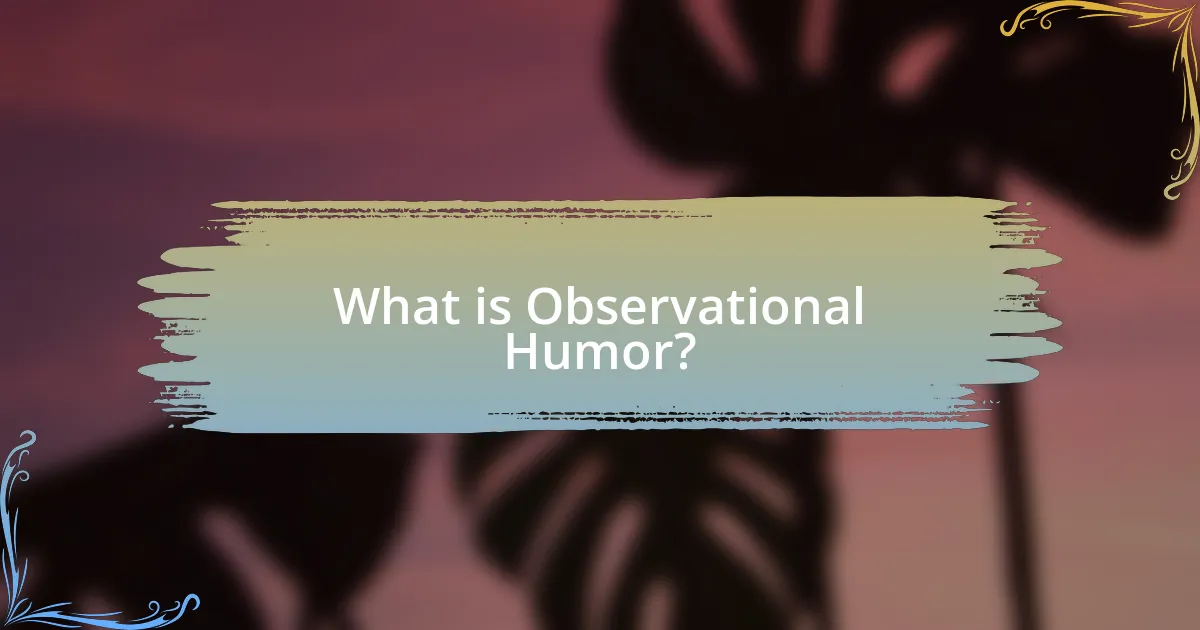Observational humor is a comedic style that draws humor from everyday situations and common experiences, making it relatable to a broad audience. This article explores the characteristics of observational humor, its effectiveness in connecting with audiences, and the common themes that comedians utilize, such as family dynamics and social interactions. It also discusses the role of cultural references, the challenges comedians face, and techniques for developing observational humor skills. Notable comedians like Jerry Seinfeld and Ellen DeGeneres exemplify this style, showcasing how mundane topics can serve as rich sources of comedic material.

What is Observational Humor?
Observational humor is a comedic style that derives humor from everyday situations and common experiences. This type of humor often highlights the absurdities and quirks of daily life, making it relatable to a wide audience. Comedians like Jerry Seinfeld and Ellen DeGeneres exemplify this style by focusing on mundane topics, such as relationships and social interactions, to elicit laughter. The effectiveness of observational humor lies in its ability to resonate with people’s shared experiences, making the humor feel familiar and accessible.
How does Observational Humor differ from other types of humor?
Observational humor differs from other types of humor by focusing on relatable, everyday situations and experiences that resonate with a broad audience. Unlike forms such as slapstick or dark humor, which rely on physical comedy or taboo subjects, observational humor highlights the absurdities and quirks of daily life, making it accessible and often more universally understood. This type of humor often draws on common experiences, such as family dynamics or social interactions, allowing audiences to connect personally with the material. Comedians like Jerry Seinfeld exemplify this style, as they often base their routines on mundane topics, demonstrating how ordinary life can be a rich source of comedic material.
What are the key characteristics of Observational Humor?
Observational humor is characterized by its focus on everyday situations and relatable experiences. This type of humor often highlights the absurdities and quirks of daily life, making it accessible to a wide audience. Key characteristics include keen observation of social norms, the use of irony and exaggeration, and a conversational tone that invites the audience to reflect on their own experiences. For instance, comedians like Jerry Seinfeld have built their careers on observational humor by discussing mundane topics such as waiting in line or the intricacies of relationships, which resonate with many people. This relatability is a crucial element that enhances the comedic effect and fosters a connection between the comedian and the audience.
Why is Observational Humor effective in connecting with audiences?
Observational humor is effective in connecting with audiences because it draws on shared experiences and relatable situations. By highlighting the mundane aspects of everyday life, comedians create a sense of familiarity that resonates with the audience. This connection is reinforced by the fact that humor often arises from common frustrations or absurdities that many people encounter, making the content accessible and engaging. Research indicates that humor based on shared experiences can enhance social bonding and increase audience engagement, as seen in studies on laughter and group dynamics.
What are common themes in Observational Humor?
Common themes in observational humor include everyday life experiences, social norms, and human behavior. These themes often highlight the absurdities and quirks of daily situations, such as interactions in public spaces, family dynamics, and the challenges of modern living. For instance, comedians frequently draw attention to mundane activities like grocery shopping or commuting, emphasizing the relatable frustrations and humorous aspects of these experiences. This approach resonates with audiences because it reflects shared realities, making the humor accessible and engaging.
How do everyday situations inspire Observational Humor?
Everyday situations inspire observational humor by providing relatable experiences that highlight the absurdities of daily life. Comedians often draw from common scenarios, such as interactions in public spaces or mundane tasks, to create humor that resonates with a wide audience. For example, Jerry Seinfeld famously uses the quirks of everyday life, like waiting in line or dealing with telemarketers, to illustrate universal truths, making his observations both funny and accessible. This relatability is crucial, as it allows audiences to see themselves in the humor, reinforcing the connection between the comedian and the audience.
What role do cultural references play in Observational Humor?
Cultural references play a crucial role in observational humor by providing relatable context that enhances the comedic effect. These references allow comedians to connect with their audience through shared experiences, norms, and values, making the humor more accessible and impactful. For instance, when a comedian mentions a popular television show or a widely recognized cultural phenomenon, it taps into the audience’s collective memory, creating a sense of familiarity that amplifies the laughter. Studies have shown that humor is often more effective when it resonates with the audience’s cultural background, as evidenced by the success of comedians who incorporate local or contemporary references into their routines.
Why is Observational Humor popular among comedians?
Observational humor is popular among comedians because it resonates with audiences by highlighting relatable, everyday experiences. This type of humor allows comedians to connect with their audience on a personal level, as it often reflects common situations that people encounter in their daily lives. For instance, comedians like Jerry Seinfeld have built successful careers by focusing on mundane topics, such as waiting in line or the quirks of social interactions, making their observations universally relatable. The effectiveness of observational humor is supported by its ability to evoke laughter through shared understanding, making it a staple in stand-up comedy.
How do comedians use personal experiences in Observational Humor?
Comedians use personal experiences in observational humor by drawing on relatable situations from their own lives to connect with audiences. This technique allows them to highlight the absurdities and quirks of everyday life, making their material more engaging and authentic. For instance, comedians often recount personal anecdotes about family dynamics, social interactions, or mundane activities, which resonate with the audience’s own experiences. Research shows that humor derived from shared experiences fosters a sense of community and understanding, enhancing the comedic impact. By using specific details from their lives, comedians create vivid imagery that enhances relatability, making their observations more effective and memorable.
What impact does Observational Humor have on audience engagement?
Observational humor significantly enhances audience engagement by creating relatable content that resonates with shared experiences. This type of humor draws on everyday situations, making it easier for audiences to connect emotionally and cognitively with the material. Research indicates that humor increases attention and retention; for instance, a study published in the journal “Communication Research” found that humorous content can improve audience recall by up to 50%. By tapping into common life experiences, observational humor fosters a sense of community among audience members, leading to increased laughter and interaction, which further amplifies engagement levels.
How can one develop skills in Observational Humor?
To develop skills in observational humor, one should practice keen observation of everyday situations and interactions. This involves actively noticing details, behaviors, and social dynamics that others may overlook, which can serve as the foundation for humorous commentary. Engaging in regular reflection on these observations and experimenting with different comedic styles can enhance one’s ability to articulate humor effectively. Research indicates that comedians often draw from personal experiences and relatable scenarios, making their humor more accessible and engaging to audiences. By honing these observational skills and understanding the nuances of timing and delivery, individuals can improve their capacity to create humor from ordinary life.
What techniques can be used to identify humorous observations?
Techniques to identify humorous observations include analyzing incongruity, employing exaggeration, and recognizing relatable experiences. Incongruity involves identifying situations where expectations are subverted, leading to surprise and laughter. Exaggeration amplifies characteristics or situations to absurd levels, making them humorous. Recognizing relatable experiences taps into shared human conditions, allowing audiences to connect and find humor in everyday life. Research by Martin (2007) in “The Psychology of Humor: An Integrative Approach” supports these techniques, highlighting how humor often arises from unexpected contrasts and shared experiences.
How can practice enhance one’s ability to deliver Observational Humor?
Practice enhances one’s ability to deliver observational humor by refining timing, improving delivery, and increasing familiarity with comedic structures. Regular practice allows individuals to experiment with different styles and techniques, leading to a better understanding of what resonates with audiences. For instance, comedians often rehearse their material to perfect the pacing and inflection, which are crucial for maximizing comedic impact. Studies show that performers who engage in consistent practice report higher confidence levels and improved audience engagement, as they become adept at reading reactions and adjusting their performance accordingly.
What are the challenges of using Observational Humor?
The challenges of using observational humor include the risk of alienating audiences, as humor based on everyday situations may not resonate universally. Different cultural backgrounds and personal experiences can lead to varied interpretations of the same observation, making it difficult for comedians to connect with all audience members. Additionally, observational humor often relies on timing and delivery; if not executed well, the intended humor can fall flat. Furthermore, comedians must navigate the fine line between relatable and cliché, as overused observations can diminish the impact of the humor. These challenges highlight the need for comedians to be attuned to their audience and to continuously innovate their material to maintain relevance and engagement.
How can comedians avoid clichés in Observational Humor?
Comedians can avoid clichés in observational humor by focusing on unique personal experiences and perspectives. By drawing from their own lives and specific details that resonate with their individual backgrounds, comedians can create fresh material that diverges from common tropes. Research indicates that humor is more effective when it is relatable yet distinct, as seen in the work of comedians like Jerry Seinfeld, who often emphasizes the nuances of everyday life rather than relying on overused themes. This approach not only enhances originality but also engages audiences by presenting familiar situations in a new light.
What are the risks of misinterpretation in Observational Humor?
The risks of misinterpretation in observational humor include the potential for offense, misunderstanding of intent, and cultural insensitivity. Observational humor often relies on shared experiences and social norms; when these are misinterpreted, the humor can be perceived as derogatory or inappropriate. For instance, a joke about a common social situation may inadvertently reinforce stereotypes, leading to backlash from audiences who feel marginalized. Additionally, humor that is context-specific may not translate well across different cultural backgrounds, resulting in confusion or alienation. Research indicates that humor is highly context-dependent, and misalignment in understanding can diminish its effectiveness and lead to negative reactions.
How can Observational Humor be applied in everyday life?
Observational humor can be applied in everyday life by recognizing and commenting on the mundane aspects of daily experiences that others may overlook. This type of humor often involves making light of common situations, such as the quirks of public transportation or the idiosyncrasies of social interactions, which can foster connection and laughter among individuals. For instance, comedians like Jerry Seinfeld have built careers on observational humor by highlighting the absurdities of everyday life, demonstrating that shared experiences can be a source of amusement. By incorporating observational humor into conversations, individuals can enhance social bonds and create a more enjoyable atmosphere in various settings, such as at work or during social gatherings.
What tips can help individuals incorporate Observational Humor into conversations?
To incorporate observational humor into conversations, individuals should focus on identifying relatable everyday situations and highlighting their absurdities. This can be achieved by keenly observing the environment, noting common behaviors or quirks that others might overlook, and then sharing these observations in a light-hearted manner. For instance, pointing out the humorous aspects of mundane tasks, like the struggle of finding matching socks, can resonate with many people. Research indicates that humor enhances social bonding and can make conversations more engaging, as noted in a study published in the Journal of Personality and Social Psychology, which found that shared laughter strengthens interpersonal connections.
How can Observational Humor improve social interactions?
Observational humor can improve social interactions by fostering connection and relatability among individuals. When people share humorous observations about everyday situations, they create a shared experience that can enhance bonding and reduce social barriers. Research indicates that laughter triggers the release of endorphins, promoting feelings of happiness and social cohesion. For instance, a study published in the journal “Psychological Science” found that shared laughter can strengthen interpersonal relationships and increase feelings of trust and cooperation among individuals. Thus, observational humor serves as a powerful tool for enhancing social dynamics and improving interpersonal communication.
What are some examples of successful Observational Humor?
Successful observational humor includes comedians like Jerry Seinfeld, who often highlights the absurdities of daily life, such as the quirks of social interactions and mundane activities. Another example is Ellen DeGeneres, who humorously discusses everyday experiences, like shopping or family dynamics, making relatable observations that resonate with audiences. Additionally, Louis C.K. has gained acclaim for his candid takes on parenting and the challenges of adult life, showcasing the humor found in personal struggles. These examples illustrate how observational humor effectively captures and amplifies the humor in common experiences, making it accessible and relatable to a wide audience.
Who are notable comedians known for their Observational Humor?
Notable comedians known for their observational humor include Jerry Seinfeld, George Carlin, and Ellen DeGeneres. Jerry Seinfeld is renowned for his ability to find humor in mundane aspects of daily life, as showcased in his iconic television show “Seinfeld,” which often revolves around trivial social situations. George Carlin’s observational style often critiques societal norms and behaviors, evident in his stand-up specials where he discusses everyday topics with sharp wit. Ellen DeGeneres employs observational humor to connect with audiences through relatable anecdotes about life experiences, as seen in her stand-up routines and daytime talk show. These comedians exemplify the effectiveness of observational humor in turning everyday situations into laughs.
What are some iconic routines that exemplify Observational Humor?
Iconic routines that exemplify observational humor include George Carlin’s “Seven Words You Can Never Say on Television,” Jerry Seinfeld’s “What’s the Deal with Airplane Food?” and Ellen DeGeneres’s “Phone Call.” These routines highlight everyday experiences and societal norms, making them relatable to audiences. For instance, Carlin’s routine critiques censorship and language, while Seinfeld’s observations about mundane aspects of life resonate widely, showcasing the effectiveness of observational humor in connecting with audiences through shared experiences.
How can one effectively share Observational Humor with others?
To effectively share observational humor with others, one should focus on relatable experiences and common situations that resonate with the audience. By identifying everyday scenarios that evoke shared feelings or thoughts, the humor becomes more impactful. For instance, comedians like Jerry Seinfeld have successfully built careers by highlighting mundane aspects of life, such as waiting in line or dealing with telemarketers, which many people find amusing due to their familiarity. This approach not only engages the audience but also fosters a sense of connection, as they recognize their own experiences in the humor being presented.





